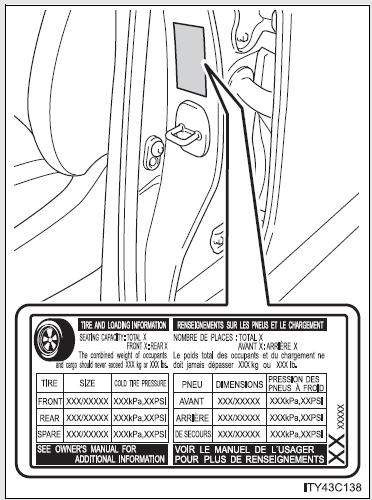 Toyota Land Cruiser Owners ManualMaintenance
and care » Do-it-yourself maintenance
Toyota Land Cruiser Owners ManualMaintenance
and care » Do-it-yourself maintenance
Tire inflation pressure
Tire inflation pressure
- Tire inflation pressure
The recommended cold tire inflation pressure and tire size is displayed on the tire and loading information label.

- Inspection and adjustment procedure

- Tire valve
- Tire pressure gauge
STEP 1
Remove the tire valve cap.
STEP 2
Press the tip of the tire pressure gauge onto the tire valve.
STEP 3
Read the pressure using the graduations of the gauge.
STEP 4
If the tire inflation pressure is not within the recommended levels, adjust tire pressure.
If you add too much air, press the center of the valve to lower.
STEP 5
After completing the tire inflation pressure measurement and adjustment, apply soapy water to the valve and check for leakage.
STEP 6
Reinstall the tire valve cap.
Make sure to maintain the proper tire inflation pressure. Tire inflation pressure should be checked at least once per month. However, Toyota recommends that tire inflation pressure be checked once every two weeks.
- Tire inflation pressure check interval
You should check tire inflation pressure every 2 weeks, or at least once a month.
Do not forget to check the spare.
- Effects of incorrect tire inflation pressure
Driving with incorrect tire inflation pressure may result in the following:
- Reduced fuel efficiency
- Reduced driving comfort and tire life
- Reduced safety
- Damage to the drive train
If a tire needs frequent refilling, have it checked by your Toyota dealer.
- Instructions for checking tire inflation pressure
When checking tire inflation pressure, observe the following:
- Check only when the tires are cold.
If your vehicle has been parked for at least 3 hours and has not been driven for more than 1 mile or 1.5 km, you will get an accurate cold tire inflation pressure reading.
- Always use a tire pressure gauge.
The appearance of the tire can be misleading. In addition, tire inflation pressures that are even just a few pounds off can degrade ride and handling.
- Do not bleed or reduce tire inflation pressure after driving. It is normal for the tire inflation pressure to be higher after driving.
- Never exceed the vehicle capacity weight.
Passengers and luggage weight should be placed so that the vehicle is balanced.
CAUTION
Keep your tires properly inflated. Otherwise, the following conditions may occur and result in an accident causing death or serious injury.
|
NOTICE
Be sure to reinstall the tire valve caps. Without the valve caps, dirt or moisture could get into the valve and cause air leakage, which could result in an accident. If the caps have been lost, replace them as soon as possible. |
